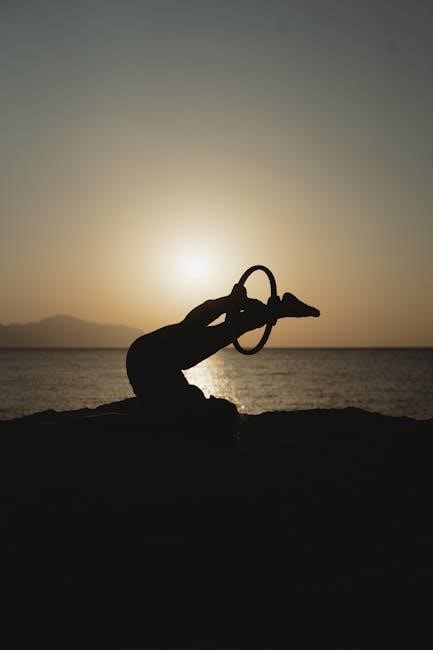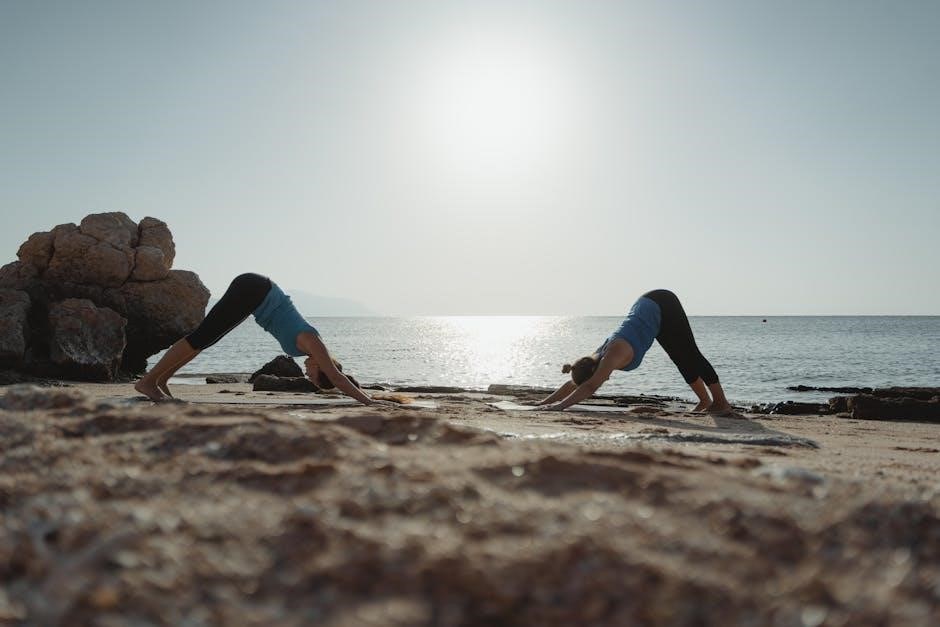Proprioception Exercises PDF: A Comprehensive Guide
This guide explores proprioception exercises, crucial for body awareness, balance, and coordination. Improving proprioception can help you to avoid falls and reduce the risk of injury. Discover various exercises, from simple balance techniques to advanced movements, often outlined in readily available PDFs for easy access and implementation.
What is Proprioception?
Proprioception, often referred to as the “sixth sense,” is your body’s ability to sense its location, movements, and actions. It’s the unconscious awareness of where your body is in space. This sense relies on proprioceptors, sensory receptors located in muscles, tendons, and joints. These receptors transmit information about joint angle, muscle length, and tension to the brain, which then interprets this data to create a mental map of the body.
Imagine being able to touch your nose with your eyes closed or walking without consciously thinking about each step. That’s proprioception at work. It’s essential for movement control, coordination, and balance. When proprioception is impaired, it can lead to clumsiness, instability, and an increased risk of falls.
Good proprioception allows for smooth, fluid movements and quick reactions. It’s like having an internal GPS that constantly updates your brain on your body’s position. This awareness is crucial for both everyday activities and athletic performance. Understanding proprioception is the first step in appreciating its importance and how exercises can enhance this vital sense.
The Importance of Proprioception
Proprioception plays a pivotal role in numerous aspects of our lives, from basic movements to complex athletic skills. Without it, even simple actions like walking or reaching for an object would require immense concentration and effort; It is essential for maintaining balance, coordinating movements, and reacting quickly to changes in our environment.
In rehabilitation, proprioception is crucial for recovery after injuries, especially those affecting joints and muscles. Injuries like ankle sprains or knee ligament tears often disrupt proprioceptive pathways, leading to instability and an increased risk of re-injury. Proprioceptive exercises help retrain the body to sense its position, improving joint stability and reducing the likelihood of future problems.
Furthermore, proprioception is vital for athletes, enabling them to perform complex movements with precision and control. It allows athletes to adjust their body position quickly and efficiently, maximizing performance and minimizing the risk of injury. Balance training, a key component of proprioceptive training, helps fine-tune this system, enhancing reflexes and overall athletic ability.
Even in daily life, good proprioception is essential for preventing falls, especially in the elderly. As we age, proprioception naturally declines, increasing the risk of falls and related injuries. Specific exercises can help maintain and improve proprioception, promoting stability and confidence in movement.
Benefits of Proprioception Exercises
Proprioception exercises offer a wide array of benefits that extend beyond just physical rehabilitation. They enhance body awareness, improve balance and coordination, and contribute significantly to injury prevention. By stimulating nerve endings and retraining the body’s ability to sense its position in space, these exercises promote more efficient and controlled movement.
One of the primary benefits is improved stability, especially in joints affected by injuries. For example, after an ankle sprain, proprioceptive exercises can help restore the joint’s ability to respond to changes in terrain, reducing the risk of re-injury; This enhanced stability is crucial for athletes and individuals engaging in activities that require quick changes in direction.
Furthermore, proprioception exercises can lead to better overall athletic performance. By improving body awareness and coordination, athletes can execute complex movements with greater precision and control. This can translate to improved agility, faster reaction times, and enhanced power output.
In addition to physical benefits, proprioception exercises can also have a positive impact on mental well-being. Improved body awareness can lead to a greater sense of confidence and control, reducing anxiety and fear of falling. This is particularly important for the elderly, who may experience a decline in proprioception due to age-related changes.
Finally, these exercises are often simple to perform and require minimal equipment, making them accessible to a wide range of individuals. They can be easily incorporated into daily routines, promoting long-term benefits for both physical and mental health.
Proprioception Exercises for Lower Limb Injuries
Lower limb injuries, such as ankle sprains, knee ligament tears, and hip instability, often disrupt proprioception, impairing balance and coordination. Targeted proprioception exercises are crucial for restoring sensorimotor control and preventing re-injury. These exercises aim to retrain the body’s awareness of joint position and movement, enhancing stability and functional performance.
For ankle sprains, exercises like single-leg stance on varied surfaces (foam pads, wobble boards) challenge the ankle’s ability to maintain balance. Progressing to dynamic activities like hopping and agility drills further enhances proprioceptive feedback. Similarly, knee injuries benefit from exercises that focus on joint stability and neuromuscular control. These may include balancing on one leg while performing small knee bends, using resistance bands to challenge stability, and incorporating plyometric exercises to improve reactive strength.
Hip injuries can also benefit from proprioception training. Exercises such as single-leg deadlifts, hip abduction with resistance bands, and balance exercises on unstable surfaces help to improve hip stability and control. The key is to gradually increase the difficulty and complexity of the exercises as the individual’s proprioceptive abilities improve.
It’s important to note that proprioception exercises should be performed under the guidance of a qualified healthcare professional, such as a physical therapist. They can assess the individual’s specific needs and tailor the exercises accordingly. Early intervention with proprioception exercises is essential for optimal recovery and long-term functional outcomes following lower limb injuries.

Proprioception Exercises for the Knee
Knee injuries frequently compromise proprioception, impacting stability and control. Specific exercises are vital to restore this sense and prevent re-injury. These exercises aim to improve the communication between the brain and the muscles surrounding the knee, enhancing joint awareness and dynamic stability.

Simple exercises, like standing on one leg with a slightly bent knee, can be a starting point. Progressing this by adding small perturbations or using an unstable surface, such as a balance pad, increases the challenge. Another effective exercise involves controlled knee bends while maintaining balance, focusing on proper form and alignment.
More advanced exercises include agility drills, such as cone hops and carioca steps, which require rapid changes in direction and body position. These activities challenge the knee’s ability to react quickly and maintain stability under dynamic conditions. Resistance bands can also be incorporated to add an element of strength training, further enhancing proprioceptive feedback.
It’s crucial to perform these exercises with proper technique and under the guidance of a physical therapist or qualified healthcare professional. They can tailor the exercises to individual needs and ensure safe progression. Consistency is also key; regular practice of these exercises will help to improve proprioception and reduce the risk of future knee injuries. Focus on controlled movements and maintaining balance throughout each exercise to maximize the benefits.
Proprioception Exercises for Ankle Sprains
Ankle sprains often disrupt proprioception, leading to instability and increased risk of re-injury. Targeted exercises are crucial for restoring the ankle’s ability to sense its position in space and react to changes in terrain or balance.

Initial exercises may involve simple weight shifting while standing, gradually increasing the range of motion. Single-leg stance is another fundamental exercise, progressing from eyes open to eyes closed to challenge balance further. Wobble board or balance disc exercises are also effective, requiring the ankle to make constant adjustments to maintain stability. Incorporating resistance bands can add a strength component while improving proprioceptive feedback.
More advanced exercises can include agility drills such as hopping, jumping, and running patterns that simulate sport-specific movements. These exercises should be performed with controlled movements and proper form to avoid re-injury. Balance training can fine-tune the proprioceptive system and improve coordination. Exercises like heel-to-toe walking and balancing on uneven surfaces can further challenge the ankle’s stability.
It’s essential to progress gradually and listen to your body, avoiding any exercises that cause pain. A physical therapist can guide you through a tailored program and ensure correct technique. Regular and consistent practice of these exercises is key to regaining proprioception and reducing the risk of future ankle sprains. By improving your ankle’s awareness, you can improve your confidence in getting around.
Proprioception Exercises for the Shoulder
The shoulder joint, known for its wide range of motion, is also vulnerable to instability and injury. Proprioception exercises play a vital role in restoring and enhancing shoulder stability, coordination, and function, especially after injury or surgery.
Early-stage exercises often focus on regaining awareness of shoulder position and movement. Simple activities like arm circles, pendulum exercises, and scapular retractions can help re-establish the mind-muscle connection. Resistance bands can be incorporated to add gentle resistance and improve muscle activation.
As strength and stability improve, more challenging exercises can be introduced. These may include wall slides, rhythmic stabilization exercises using a therapy ball, and weight-bearing activities like planks or push-ups against a wall. The goal is to challenge the shoulder’s ability to control movement and maintain stability in various positions.
Sport-specific exercises are crucial for athletes returning to overhead activities. These drills may involve throwing, swinging, or reaching movements that simulate the demands of their sport. The focus is on maintaining proper form and control throughout the movement.
Throughout the rehabilitation process, it’s important to progress gradually and listen to your body. A physical therapist can assess your individual needs and develop a tailored exercise program to optimize your shoulder’s proprioceptive abilities, reduce pain, and prevent future injuries. Regular training helps in transmission of messages between sensors and muscles.
Balance Exercises for Proprioception
Balance exercises are fundamental for improving proprioception, as they directly challenge the body’s ability to sense its position in space and maintain stability. These exercises train the nervous system to react quickly and efficiently to changes in balance, reducing the risk of falls and injuries.
Simple balance exercises can be performed anywhere, requiring minimal or no equipment. Starting with a wide stance and gradually narrowing it is a good way to improve balance. Standing on one leg, first with eyes open and then closed, is a classic proprioception exercise. Incorporating head turns or arm movements while balancing adds an extra challenge.
More advanced balance exercises involve unstable surfaces like balance boards, wobble cushions, or foam pads. These surfaces force the body to constantly adjust and maintain equilibrium, further enhancing proprioceptive abilities. Activities like single-leg squats on a balance board or walking heel-to-toe on a foam pad are effective for challenging balance.
Dynamic balance exercises, such as walking lunges or agility drills, incorporate movement while maintaining balance. These exercises are particularly beneficial for athletes and individuals who need to react quickly and maintain stability during dynamic activities.
Regularly incorporating balance exercises into your routine can significantly improve proprioception, leading to better coordination, stability, and a reduced risk of falls, especially as we age. Remember to start slowly, progress gradually, and always prioritize safety. Ensure you perform the exercise at your kitchen bench or an area with support.
Proprioception Exercises for the Elderly to Prevent Falls
Falls are a significant concern for the elderly, often leading to injuries and reduced quality of life. Proprioception exercises play a vital role in preventing falls by improving balance, coordination, and body awareness. As we age, our proprioceptive abilities naturally decline, making us more susceptible to instability.
Simple exercises can be easily incorporated into daily routines to combat this decline. Standing on one leg for short periods, even while holding onto a stable surface, helps improve balance. Weight shifting exercises, where you gently move your weight from one foot to the other, enhance stability and coordination.
Walking heel-to-toe, focusing on each step, challenges balance and strengthens proprioceptive pathways. Tai Chi, with its slow, controlled movements, has been shown to improve proprioception and reduce the risk of falls in older adults. These movements require constant adjustment and awareness of body position.
Balance exercises using support, such as holding onto a chair or wall, are a safe way to start. As confidence and stability increase, gradually reduce the support. Incorporating exercises that challenge balance in different directions, such as sideways or backward steps, further enhances proprioceptive abilities.
It’s crucial to consult with a healthcare professional before starting any new exercise program, especially if you have underlying health conditions. Regular proprioception exercises can significantly improve balance, coordination, and confidence, reducing the risk of falls and promoting a more active and independent lifestyle for the elderly.
Proprioception Exercises for Athletes
For athletes, proprioception is paramount, underpinning agility, coordination, and injury prevention. Enhanced proprioception allows athletes to react swiftly and efficiently, maintaining balance and control during dynamic movements. Specific exercises can sharpen this crucial sense, giving athletes a competitive edge.
Single-leg balance drills on varied surfaces, like balance boards or foam pads, challenge stability and improve joint awareness. Agility ladder drills, focusing on precise foot placement, enhance coordination and proprioceptive feedback. Plyometric exercises, such as box jumps and single-leg hops, develop explosive power while refining balance and control.
Sport-specific drills that mimic game-like situations further refine proprioception. For example, a basketball player might practice dribbling while balancing on one leg, or a soccer player might work on passing accuracy while maintaining balance after a quick turn. Incorporating unstable surfaces during strength training exercises, such as using dumbbells while standing on a balance board, increases muscle activation and improves proprioception.
Rhythmic stabilization exercises, involving resisted movements in multiple directions, enhance joint stability and proprioceptive awareness. These exercises train the body to react quickly to unexpected forces, reducing the risk of injuries like ankle sprains or knee ligament tears.
Regular proprioceptive training should be an integral part of any athlete’s training regime. It not only enhances performance but also plays a crucial role in preventing injuries and ensuring longevity in their sport. By consistently challenging and refining their proprioceptive abilities, athletes can unlock their full potential and minimize their risk of setbacks.
Examples of Proprioception Exercises (with Support, Walking, Ball)
Proprioception exercises come in diverse forms, catering to varying levels and needs. Utilizing support, incorporating walking, and employing a ball can enhance body awareness and balance.

With Support: A simple starting point is single-leg stance, holding onto a chair or wall for balance. Gradually reduce reliance on support as stability improves. Another exercise involves weight shifting while holding onto a stable surface, focusing on controlled movements and feeling the body’s center of gravity change.
Walking: Heel-to-toe walking, also known as tandem walking, challenges balance and coordination. Focus on maintaining a straight line and controlled steps. Incorporate variations like walking on uneven surfaces (grass, sand) to further engage proprioceptors. Another walking exercise involves changing directions quickly, promoting agility and responsiveness.
Ball: Using a ball introduces instability and requires constant adjustments. Try balancing on a stability ball while performing simple movements like arm raises or squats. Wall ball squats, where a ball is placed between the back and the wall during squats, can improve posture and core stability. Passing a ball between hands while balancing on one leg challenges coordination and balance simultaneously.
These examples demonstrate how proprioception exercises can be modified and progressed. Remember to focus on controlled movements, proper form, and listening to your body. These exercises can be integrated into daily routines or dedicated training sessions to improve overall body awareness and reduce the risk of injury.
Resources for Proprioception Exercises (PDFs)
How to Perform Proprioception Exercises Correctly
Performing proprioception exercises correctly is crucial for maximizing their benefits and preventing injuries. Start with a foundation of proper posture and body alignment. Engage your core muscles to provide stability and control throughout each movement. Focus on controlled, deliberate actions rather than rushing through the exercises.
Begin with simpler exercises and gradually progress to more challenging ones as your balance and coordination improve. Pay close attention to your body’s feedback. Be aware of how your joints and muscles are moving and adjusting to maintain balance.
Use a mirror to monitor your form and ensure proper alignment, especially when starting. If you’re unsure about the correct technique, consult with a physical therapist or qualified trainer.
Maintain a consistent breathing pattern throughout the exercises. Avoid holding your breath, as this can increase tension and reduce stability.
Listen to your body and stop if you experience any pain. It’s normal to feel some muscle fatigue, but sharp or persistent pain indicates that you’re pushing too hard or performing the exercise incorrectly. Start with short sessions and gradually increase the duration and intensity as your body adapts.
Consistency is key. Aim to perform proprioception exercises regularly, ideally several times a week, to maintain and improve your body awareness and balance.


